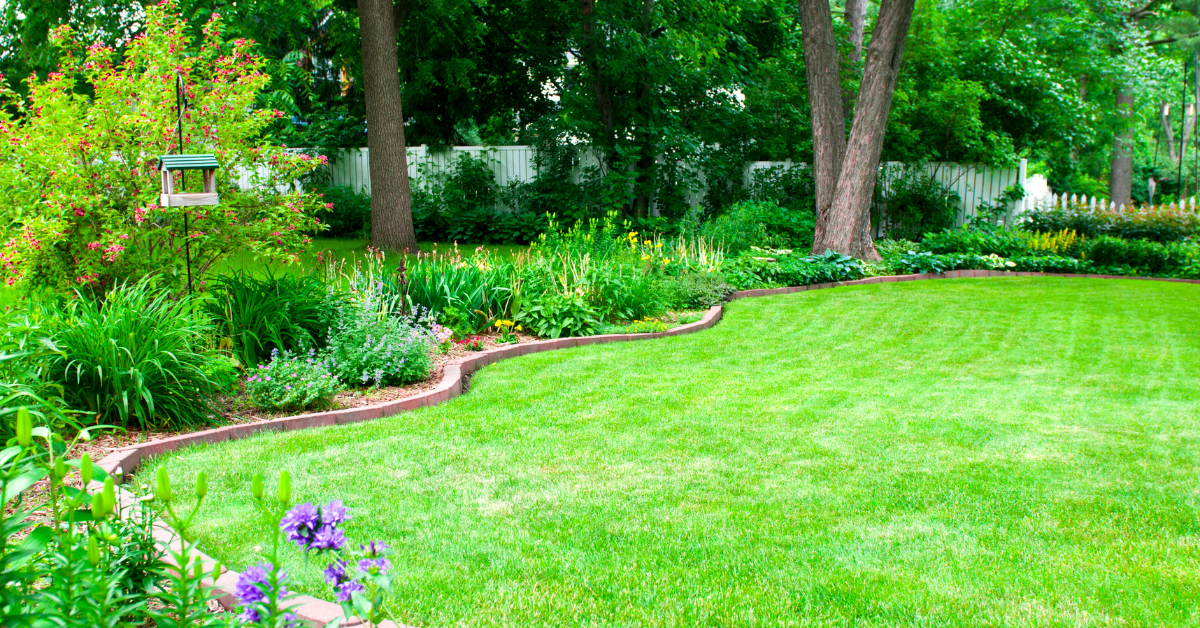
Garden bed edging is a great way to add structure, a clean edge and definition to your outdoor space. It visually helps your eye separate the lawn area and the garden beds and helps your yard feel neat and organized. It can also help accentuate the design style you prefer.
Lawn edging clearly establishes the boundaries of your garden. A garden edge can create a boundary that helps stop weeds from spreading. Additionally, it can help keep soil and mulch in your garden space from washing away during heavy rains or wind.
Edging can be a beautiful decorative touch - like the icing on a cake that finishes your garden design.
What can you use to edge a garden bed?
You can use a variety of materials to edge your garden bed, such as bricks, stones, rocks, metal or edging strips.
Each type of edging has its own pros and cons that will vary based on your climate, budget and needs (more on this below)!
Have fun with your edging! Bricks and pavers can be laid in a variety of patterns and come in a wide range of colors, allowing you to create the perfect look for your garden. Stones are a great option if you want a more natural look, while logs can be used to create a rustic atmosphere. Edging strips are a great option if you want a quick and easy solution as they can be quickly installed and provide a neat finished look.
In this article, we will dive into numerous different options and how to make sure your selection complements - or is the perfect contrast - with your space.
Corten Steel Edging
Corten steel edging is a great finishing touch to a modern garden in a modern landscape design. We also like it as an option for a contemporary space or to compliment the colors in a Southwestern design. It's strong, durable, and weather-resistant, making it perfect for outdoor use.
Corten steel edging comes in a variety of shapes and sizes, so you can easily customize the design to fit your needs. It can be bent into curves as well. Plus, the rust-like finish is meant to have a beautiful weathered look, making it a nice fit for a garden and providing a pop along the border.
This edging is low-maintenance and will last for many years, making it a great choice for any landscape.
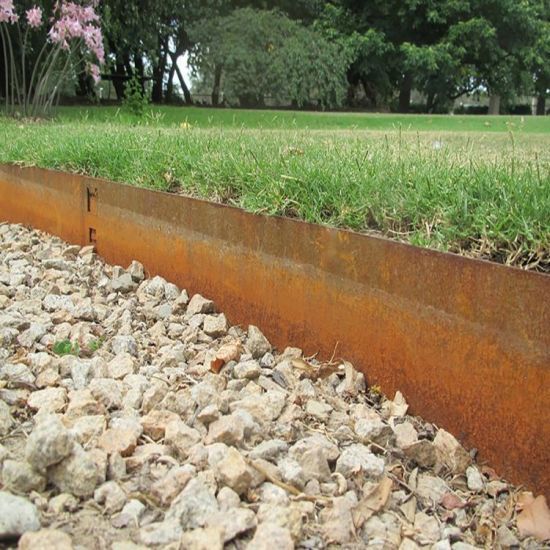
Composite Edging
Composite edging is a great option for garden beds (and decks!). It's made of a combination of wood fibers and recycled plastic, so it's durable and low-maintenance.
It comes in a variety of colors, so you can find one to coordinate with your garden beds and landscape. Composite edging is easy to install and can handle the changing temperatures and moisture levels in the soil. It's also resistant to rot, fungus, and insects.
Composite edging won't need to be replaced like some wood edging options. So, if you're looking for a great way to frame your garden bed and keep it neat and tidy, composite edging is definitely worth considering.

Metal
Thin metal edging is an effective option to provide a neat and professional finish to any project. It is available in a variety of materials and thicknesses, making it suitable for many different applications.
Thin metal edging is also relatively easy to install and can be cut to fit the exact shape or size needed. It is also durable and resistant to rust, making it a great option for outdoor projects.
In addition, thin metal edging is available in a variety of colors and finishes, allowing you to customize the look to match the surrounding environment. If you are looking for a very subtle edging option, this may be the perfect option for you.
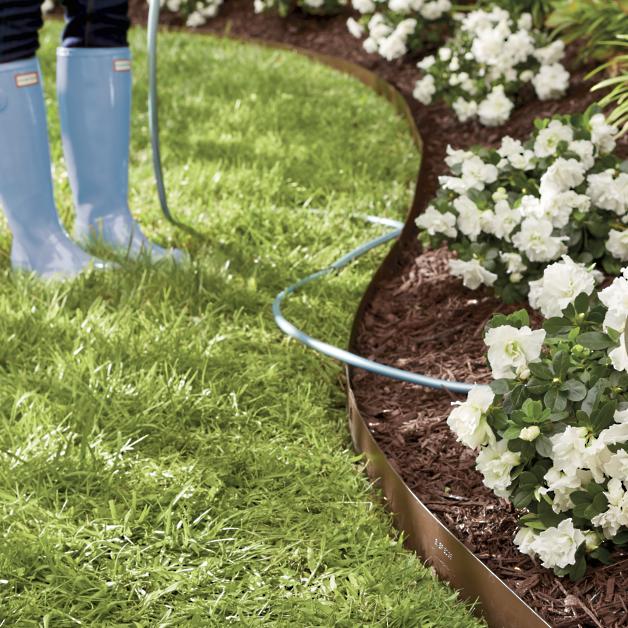
Timber Edging
Wood edging can be a great option for many different styles of garden. A crisp thicker wood edge compliments a classic or even modern garden. Whereas a weathered low level edge is a nice finish for a naturalistic, cottage or eclectic style garden.
You will want to select a wood that won't rot and is durable in your climate so do some research before you make a selection.
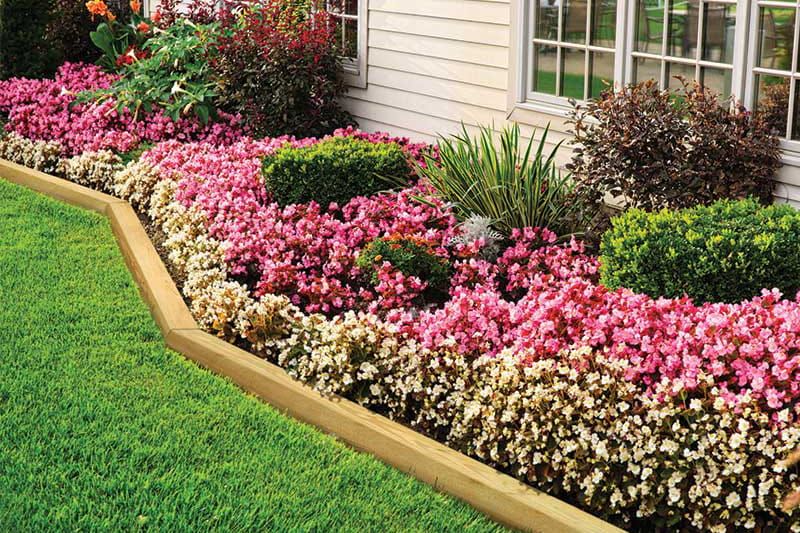
Ornate Edging
A mini ornate metal garden fence can be a beautiful addition to any garden bed edge. This is a nice way to set your garden apart from others and show some personality.
This can be used to contain plants and flowers, add a touch of elegance to the garden space, and can also be used to separate different areas of the garden. We like ornate edging to finish off an English or Cottage style garden.
This is a very durable option and easy to maintain, so it can last for many years to come. However, it won't do much in terms of keeping soil in during rain or wind.
 Photo Credit: Gardener's Supply Company
Photo Credit: Gardener's Supply CompanyStone Edges
Stone edging is an attractive and versatile way to add dimension and texture to your landscape. It can be used to create a neat border around flower beds, define a walkway, or even create a raised garden bed area.
Stone edging comes in a variety of materials and can be laid in different patterns to create a unique look. This type of edging is easy to install and maintain, and can last for many years without requiring repairs. We love the look for a little bit of extra charm to your outdoor space.
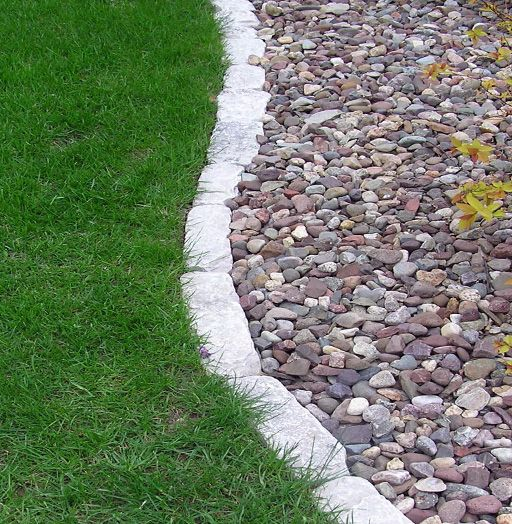
Brick Edging
Brick edging can be installed in a variety of ways, including in straight lines or curves.
This is a great decorative edging option for a rustic garden, cottage garden design or classic style yard. You can opt for traditional bricks or scalloped edged bricks!

Rocks
River rocks are a great way to add texture and style to a garden bed. They can be used to create a natural-looking edge to add definition to your garden beds.
You can use rocks in a variety of sizes, shapes and colors. To use them to edge a garden bed, start by laying a shallow trench along the edge of the bed. Next, lay the rocks carefully in the trench, filling it up completely.
You can play around with the look and style of your rock edge. Use larger rocks to create a more dramatic edge and use smaller rocks to fill in the spaces. Arrange in a thick or thin line of rocks depending on your preferences. This is a very versatile style and can also work well with a zen garden.
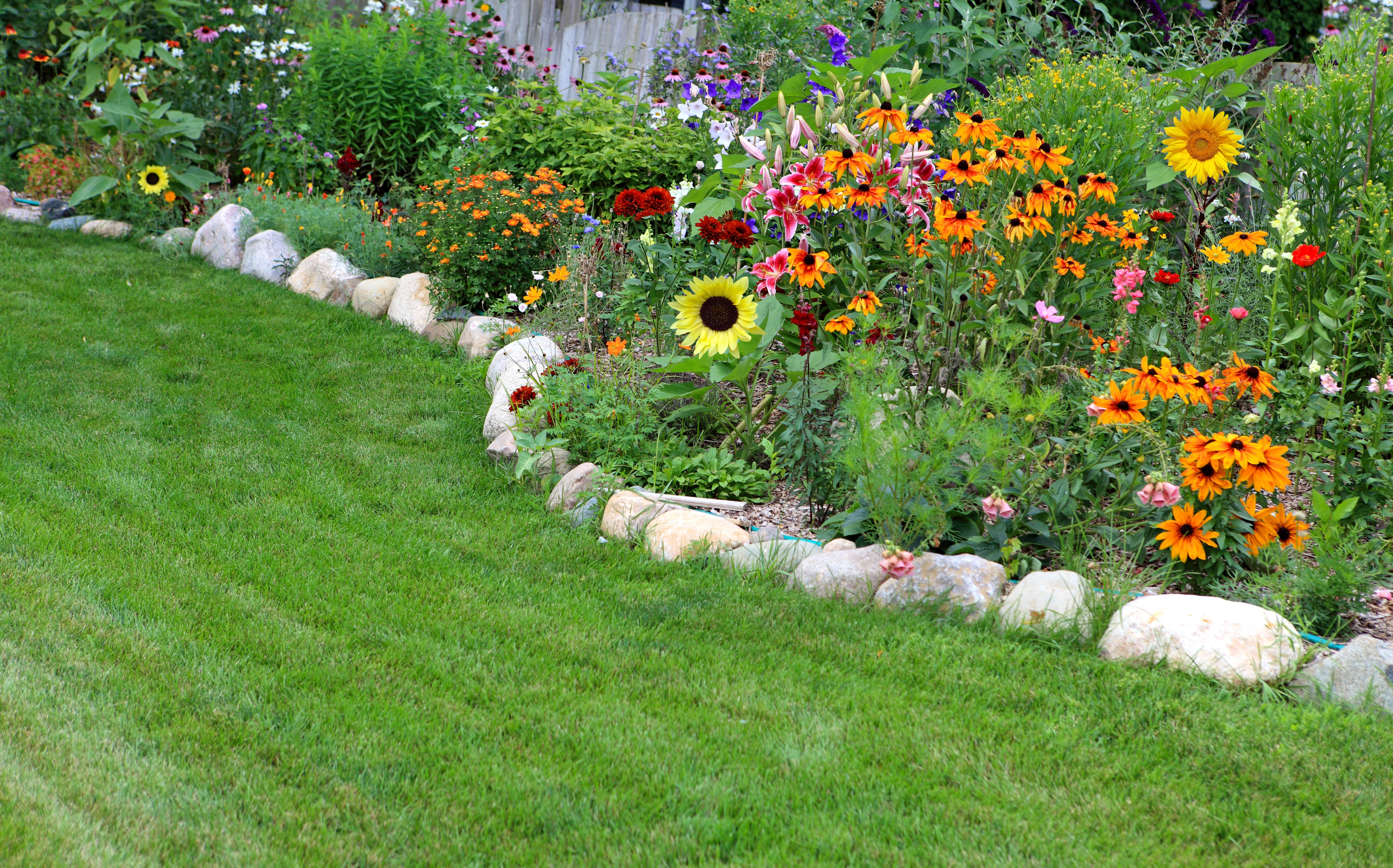
Rubber Edging
Rubber edging for garden beds is easy to install and comes in a variety of widths and colors, making it simple to match the style of your garden. Rubber edging is also durable and flexible, so it can withstand extreme temperatures and won't crack or break under pressure. It's also affordable, making it a popular option for your garden bed. You can opt for a recycled rubber to stay environmentally friendly.
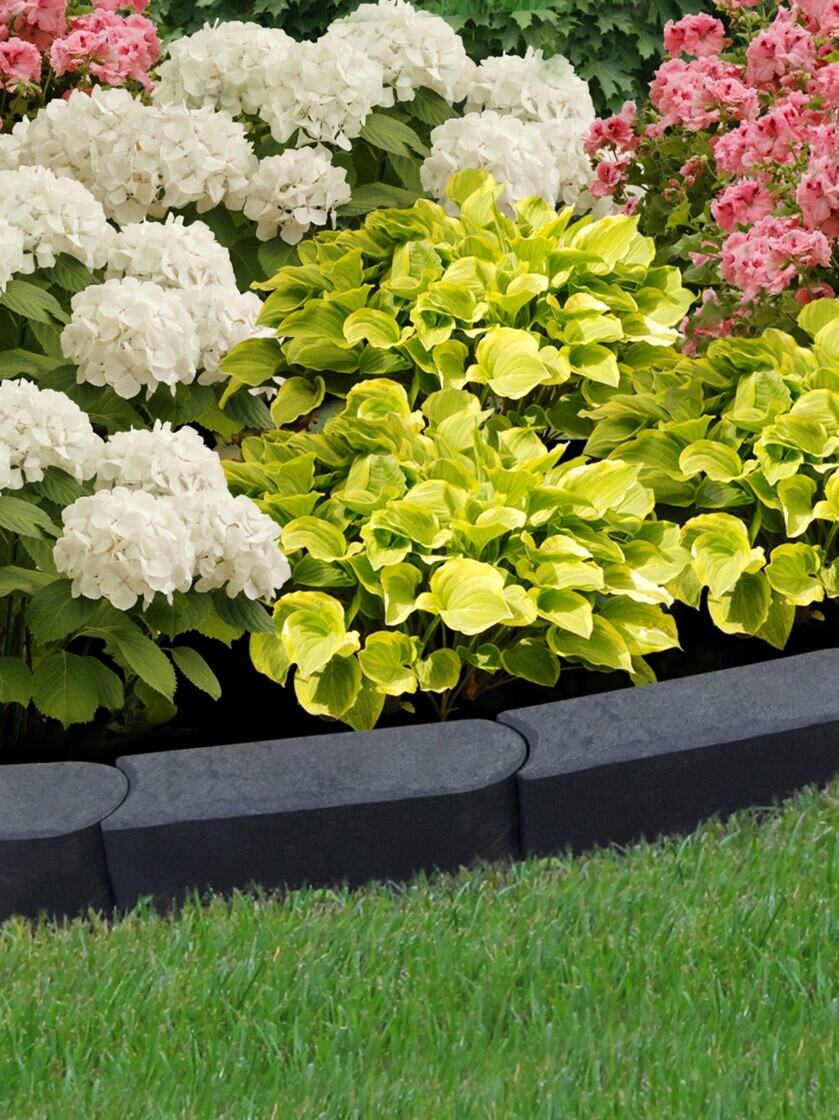
Lawn as an Edge
You don't need products to create a crisp edge. You can simply use tools, such as a flat shovel to create a natural lawn edging.
To get started, we recommend marking the designed edge with lawn paint to make sure it's exactly what you want before you start digging.
Grab an edging shovel and press it straight down into the earth. You'll create a line directly along the edge of your garden bed digging out the soil. Remove the excess soil and fill the trench with soil and tamp it down firmly. This will help to create a strong and defined edge.
Finish off the look of your garden by adding a few layers of mulch!
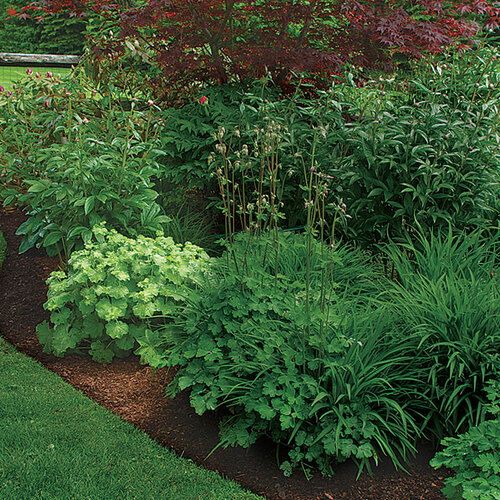
How to chose the right edging?
Choosing the right edging for your outdoor space can feel like a daunting task, but ultimately it comes down to what you find aesthetically pleasing and the practical considerations of your space. Generally you will want something that compliments your garden style.
Consider the size of your garden, the climate you live in, the type of ground cover you have, and any other special requirements. For example, if you live in a windy area, you may want to choose an edging that is sturdy and secure. If your garden is quite large, you may want an easier material to work with if you plan to DIY.
Once you have an idea of what will work for your space, you can begin to explore the different types of edging available. Wood, metal, stone, or plastic, there is a wide variety of options that can fit any budget and style.
Lastly, make sure you have the necessary tools and materials to install your edging correctly and safely. With a bit of research, you can find the perfect option for you and your outdoor space.
What is the easiest edging to install?
One of the easiest garden edges to install is recycled plastic edging. It is lightweight, easy to cut and set up, and holds its shape over time. Plastic edging also comes in a variety of colors and finishes, so it can easily blend into your garden. It is also an affordable option and can be used to create a variety of shapes and designs.
To install plastic edging, simply use a shovel to create a trench and then position the edging into the trench. Finally, use a rubber mallet to secure it into place. With plastic edging, you can quickly and easily create clean, neat garden borders without the need for professional installation (another plus for your wallet!)
What is the difference between garden walls and garden edging?
Garden walls and garden edging are two different elements of landscape design.
Garden walls serve to create boundaries, providing a backdrop for the garden and creating a sense of enclosure.
Garden edging, on the other hand, is a decorative element used to define the shape of beds, pathways, and other areas of the garden. Garden edging can be made of stone, brick, concrete, or other materials, and can be used to add texture and a unique look to the garden.
Garden walls provide a more permanent structure, while garden edging can be changed or updated with different materials or designs to give the garden a different look or feel over time.






More about Tilly
Tilly’s easy online landscape design process has been embraced by homeowners across the country and in Canada. From Texas, Florida, Colorado to Illinois - we have a team for you! Tilly designs front yards, backyard or your entire property. We match you with a professional landscape designer who is familiar with your region.
To start our process you’ll fill out a questionnaire about your property which helps our design team understand your goals, needs and existing landscape. You can add 3d renders, lighting plans or side yards to your design package. You’ll then connect with your designer on a video call and can show them your space and talk about your priorities.
When you receive your design you will be able to purchase your plants at a discounted rate through our team of plant experts and have them delivered directly to your curb. Tilly can also provide recommendations of local installers who can help you complete your landscape project.
We can’t wait to help you tackle your next yard project!
Read more about: Gardening Tips